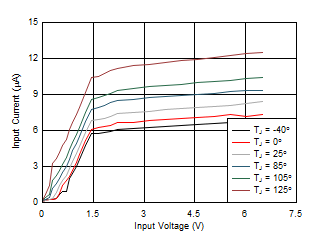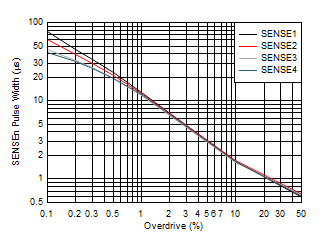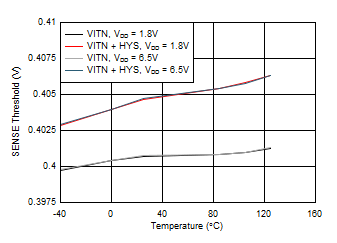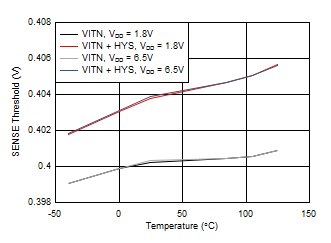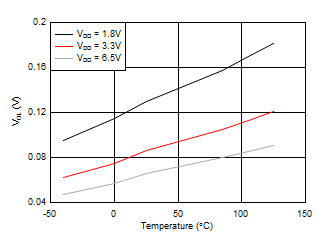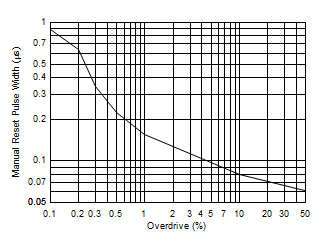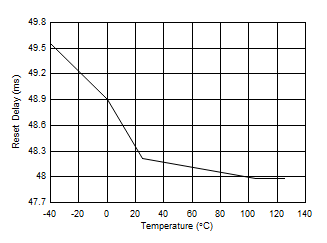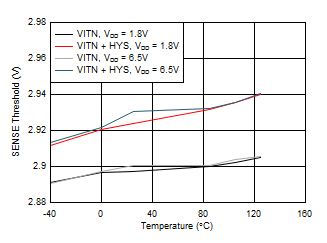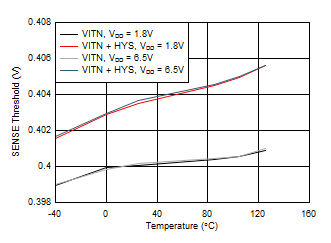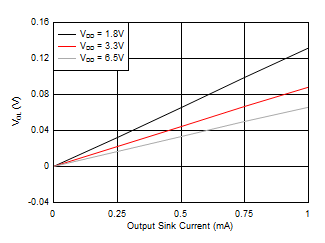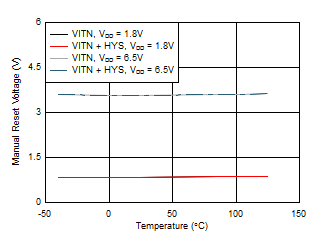SLVSA75A July 2010 – August 2015 TPS386596
PRODUCTION DATA.
- 1 Features
- 2 Applications
- 3 Description
- 4 Revision History
- 5 Pin Configuration and Functions
- 6 Specifications
- 7 Parameter Measurement Information
- 8 Detailed Description
- 9 Application and Implementation
- 10Power Supply Recommendations
- 11Layout
- 12Device and Documentation Support
- 13Mechanical, Packaging, and Orderable Information
6 Specifications
6.1 Absolute Maximum Ratings
over operating junction temperature range (unless otherwise noted).(1)(2)| MIN | MAX | UNIT | ||
|---|---|---|---|---|
| Voltage | Input, VDD | –0.3 | 7 | V |
| VMR, VSENSE1, VSENSE2, VSENSE3, VSENSE4, VRESET | –0.3 | 7 | V | |
| Current | RESET pin | 5 | mA | |
| Power dissipation | Continuous total | See Thermal Information | ||
| Temperature | Operating virtual junction, TJ | –40 | 150 | °C |
| Operating ambient, TA | –40 | 125 | ||
| Storage, Tstg | –65 | 150 | ||
(1) Stresses beyond those listed under Absolute Maximum Ratings may cause permanent damage to the device. These are stress ratings only, which do not imply functional operation of the device at these or any other conditions beyond those indicated under Recommended Operating Conditions. Exposure to absolute-maximum-rated conditions for extended periods may affect device reliability.
(2) As a result of the low dissipated power in this device, it is assumed that TJ = TA.
6.2 ESD Ratings
| VALUE | UNIT | |||
|---|---|---|---|---|
| V(ESD) | Electrostatic discharge | Human body model (HBM), per ANSI/ESDA/JEDEC JS-001(1) | ±2000 | V |
| Charged-device model (CDM), per JEDEC specification JESD22-C101(2) | ±500 | |||
(1) JEDEC document JEP155 states that 500-V HBM allows safe manufacturing with a standard ESD control process.
(2) JEDEC document JEP157 states that 250-V CDM allows safe manufacturing with a standard ESD control process.
6.3 Recommended Operating Conditions
Over operating junction temperature range (unless otherwise noted).| MIN | NOM | MAX | UNIT | ||
|---|---|---|---|---|---|
| VDD | 1.8 | 6.5 | V | ||
| VSENSE(1) | 0 | VDD | V | ||
| VMR | 0 | VDD | V | ||
| VRESET | 0 | 6.5 | V | ||
| RPULL-UP | 6.5 | 100 | 10,000 | kΩ | |
| TJ | –40 | 25 | 125 | °C | |
(1) All sense inputs.
6.4 Thermal Information
| THERMAL METRIC(1) | TPS386596 | UNIT | |
|---|---|---|---|
| DGK (VSSOP) | |||
| 8 PINS | |||
| RθJA | Junction-to-ambient thermal resistance | 174 | °C/W |
| RθJC(top) | Junction-to-case (top) thermal resistance | 45.5 | °C/W |
| RθJB | Junction-to-board thermal resistance | 94 | °C/W |
| ψJT | Junction-to-top characterization parameter | 1.9 | °C/W |
| ψJB | Junction-to-board characterization parameter | 92.7 | °C/W |
| RθJC(bot) | Junction-to-case (bottom) thermal resistance | N/A | °C/W |
(1) For more information about traditional and new thermal metrics, see the Semiconductor and IC Package Thermal Metrics application report, SPRA953.
6.5 Electrical Characteristics
Over the operating temperature range of TJ = –40°C to 125°C. 1.8 V < VDD < 6.5 V, RRESET = 100 kΩ to VDD, CRESET = 50 pF to GND, unless otherwise noted. Typical values are at TJ = 25°C.| PARAMETER | TEST CONDITIONS | MIN | TYP | MAX | UNIT | |
|---|---|---|---|---|---|---|
| VDD | Input supply | 1.8 | 6.5 | V | ||
| IDD | Supply current (current into VDD pin) | VCC = 3.3 V, RESET not asserted | 7 | 19 | µA | |
| VCC = 6.5 V, RESET not asserted | 7.5 | 22 | µA | |||
| Power-on reset voltage(1)(2) | VOL(max) = 0.2 V, IRESET = 15 µA | 0.9 | V | |||
| VITn | Negative-going input threshold accuracy | SENSE1 | 2.87 | 2.90 | 2.93 | V |
| SENSE2, SENSE3, SENSE4 | 396 | 400 | 404 | mV | ||
| VHYS | Hysteresis (positive-going) on VITn | SENSE1 | 25 | 72 | mV | |
| SENSE2, SENSE3, SENSE4 | 3.5 | 10 | mV | |||
| ISENSE1 | Input current at SENSE1 | VSENSE1 = 3.3 V | 2.2 | 2.75 | 3.3 | µA |
| ISENSEn | Input current at SENSEn pin, n = 2, 3, 4 |
VSENSEn = 0.42 V | –25 | 25 | nA | |
| td | RESETdelay time | 30 | 50 | 70 | ms | |
| VIL | MR logic low input | 0 | 0.3VDD | V | ||
| VIH | MR logic high input | 0.7VDD | V | |||
| RMR_Pullup | Internal pullup resistor on MR pin to VDD | 100 | kΩ | |||
| VOL | Low-level RESET output voltage | IOL = 1 mA | 0.4 | V | ||
| SENSEn = 0 V, 1.3 V < VDD < 1.8 V, IOL = 0.4 mA(1) |
0.3 | |||||
| ILKG | RESET leakage current | VRESET = 6.5 V, RESET not asserted | –300 | 300 | nA | |
| CIN | Input pin capacitance | 5 | pF | |||
(1) These specifications are out of recommended VDD range and only define RESET output performance during VDD ramp up.
(2) The lowest supply voltage (VDD) at which RESET becomes active. tRISE(VDD) ≥ 15 µs/V.
6.6 Timing Requirements
Over the operating temperature range of TJ = –40°C to 125°C. 1.8 V < VDD < 6.5 V, RRESET = 100 kΩ to VDD, CRESET = 50 pF to GND, unless otherwise noted. Typical values are at TJ = 25°C.| MIN | NOM | MAX | UNIT | |||
|---|---|---|---|---|---|---|
| tW | Input pulse width to SENSEn and MR pins | SENSEm: 1.05 VIT ≥ 0.95 VIT | 4 | μs | ||
| MR: 0.7 VDD ≥ 0.3 VDD | 50 | ns | ||||
6.7 Switching Characteristics
Over the operating temperature range of TJ = –40°C to 125°C. 1.8 V < VDD < 6.5 V, RRESET = 100 kΩ to VDD, CRESET = 50 pF to GND, unless otherwise noted. Typical values are at TJ = 25°C.| MIN | TYP | MAX | UNIT | |||
|---|---|---|---|---|---|---|
| tD | RESET delay time | 30 | 50 | 70 | ms | |
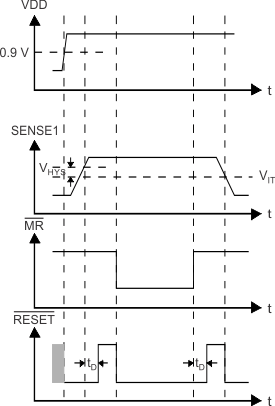 Figure 1. Timing Diagram
Figure 1. Timing Diagram
6.8 Typical Characteristics
At TA = 25°C, and VDD = 3.3 V, unless otherwise noted.